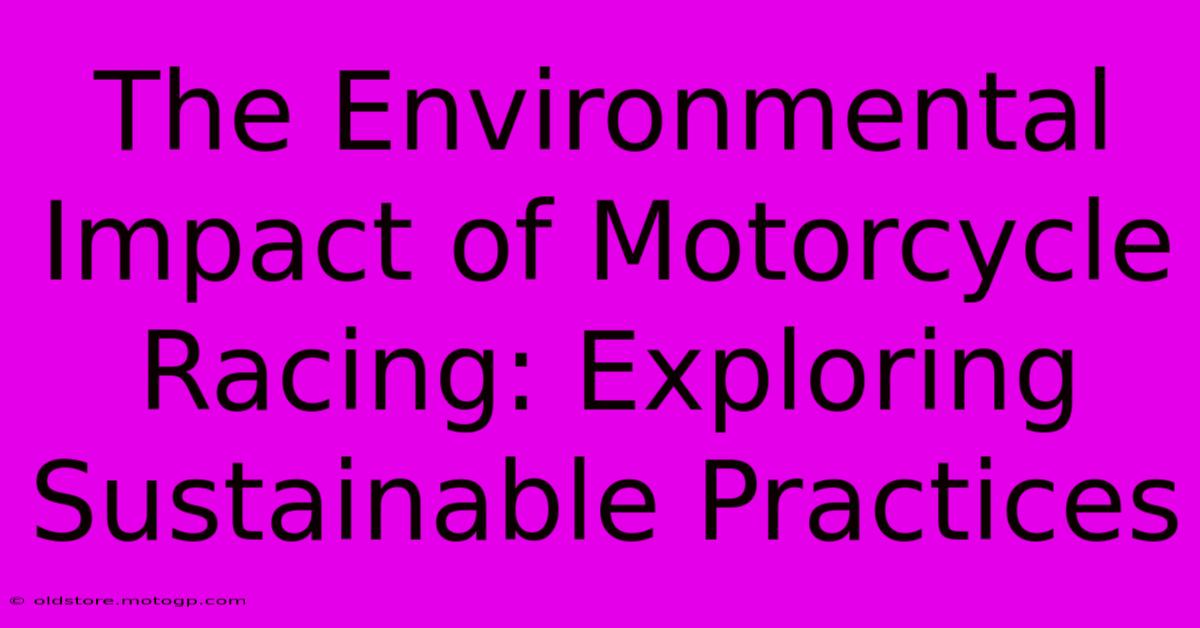The Environmental Impact Of Motorcycle Racing: Exploring Sustainable Practices

Table of Contents
The Environmental Impact of Motorcycle Racing: Exploring Sustainable Practices
Motorcycle racing, a thrilling spectacle of speed and skill, unfortunately leaves a significant carbon footprint. The roar of the engines, the smell of burning fuel – these iconic elements also represent a substantial environmental challenge. This article delves into the environmental impact of this popular sport and explores potential avenues towards more sustainable practices.
The Unseen Costs of Speed: Environmental Impacts of Motorcycle Racing
The environmental impact of motorcycle racing is multifaceted, encompassing several key areas:
1. Greenhouse Gas Emissions: A Major Contributor
The most significant environmental concern is the release of greenhouse gases (GHGs). High-performance motorcycles, particularly those used in professional racing, consume vast quantities of fuel, releasing substantial amounts of carbon dioxide (CO2), methane (CH4), and nitrous oxide (N2O) into the atmosphere. These gases contribute directly to climate change, impacting global temperatures and weather patterns. The frequent travel of teams, riders, and spectators further exacerbates this issue, adding to the overall carbon footprint.
2. Air and Noise Pollution: Local Environmental Concerns
Beyond GHGs, motorcycle racing generates considerable air and noise pollution. The combustion process releases harmful pollutants like particulate matter (PM), nitrogen oxides (NOx), and unburnt hydrocarbons, negatively impacting air quality in and around race tracks. The persistent, high-decibel noise produced by the engines can also disrupt local ecosystems and cause significant noise pollution for nearby communities.
3. Waste Generation: The Unseen Debris
Racing generates substantial waste, including used tires, fuel containers, packaging materials, and discarded parts. Improper disposal of these materials can lead to environmental contamination, particularly soil and water pollution. The sheer volume of waste generated over the course of a racing season is substantial and requires careful management.
4. Habitat Disruption: Impact on Local Ecosystems
The construction and maintenance of race tracks, often in areas of natural beauty, can lead to habitat disruption and fragmentation. This can negatively impact local flora and fauna, reducing biodiversity and potentially endangering vulnerable species.
Towards a Greener Grid: Sustainable Practices in Motorcycle Racing
While the environmental impact of motorcycle racing is undeniable, there's growing recognition of the need for sustainable practices. Several avenues are being explored:
1. Transitioning to Sustainable Fuels: Biofuels and Alternatives
The use of alternative fuels, such as biofuels or synthetic fuels, offers a promising path towards reducing GHG emissions. Research into sustainable fuel sources and their compatibility with high-performance engines is crucial.
2. Improving Engine Technology: Efficiency and Emissions Reduction
Investing in research and development to enhance engine efficiency and reduce emissions is paramount. Advances in engine design, including improvements in combustion technology and exhaust systems, can significantly minimize the environmental impact.
3. Implementing Waste Management Strategies: Reducing and Recycling
Implementing comprehensive waste management strategies, including recycling and composting programs, is essential for minimizing the waste generated during racing events. Careful planning and responsible disposal practices are crucial.
4. Promoting Sustainable Travel: Reducing the Carbon Footprint of Spectators and Teams
Encouraging sustainable transportation options for spectators and racing teams, such as public transportation, cycling, or electric vehicles, can contribute to reducing the overall carbon footprint of racing events.
5. Carbon Offsetting Initiatives: Neutralizing the Impact
Exploring carbon offsetting initiatives, where emissions are compensated for through investments in carbon reduction projects, can help neutralize the environmental impact of racing events.
Conclusion: A Balancing Act Between Thrill and Sustainability
Motorcycle racing, with its inherent speed and power, presents a significant environmental challenge. However, by adopting sustainable practices and investing in technological innovation, the sport can mitigate its impact and move towards a greener future. The path ahead requires a concerted effort from governing bodies, teams, manufacturers, and fans alike. Only through collaborative action can the thrill of motorcycle racing coexist with environmental responsibility.

Thank you for visiting our website wich cover about The Environmental Impact Of Motorcycle Racing: Exploring Sustainable Practices. We hope the information provided has been useful to you. Feel free to contact us if you have any questions or need further assistance. See you next time and dont miss to bookmark.
Featured Posts
-
F1 Concert Get Ready For A Sensory Overload
Feb 20, 2025
-
Elevate Your Cycling Race Bikes For Sale
Feb 20, 2025
-
Upgrade Your Race Day Formula 1 Parking Pass
Feb 20, 2025
-
Moto Gp Photoshoot Meet The Legends
Feb 20, 2025
-
Moto Gp The Sprint Race Showdown You Wont Want To Miss
Feb 20, 2025
